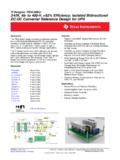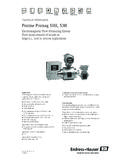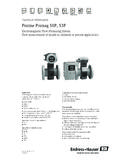Transcription of ANALYSIS OF BIDIRECTIONAL DC-DC CONVERTER FOR LOW …
1 International Journal of Power Control and Computation(IJPCSC) Vol 6. Jan-March 2014 Pp. 97-103 gopalax Journals, Singapore available at : ISSN: 0976-268X goniv Publications 97 ANALYSIS OF BIDIRECTIONAL DC-DC CONVERTER FOR LOW POWER APPLICATIONS *Sankar .V and ** *PG Scholar and **Assistant Professor Department of Electrical and Electronics Government College of Engineering, Salem, Tamil nadu,India. ABSTRACT In this paper, a BIDIRECTIONAL CONVERTER capable of operating in both buck and boost modes is proposed. The proposed CONVERTER consists of power switches and coupled inductor with equal number of turns in both primary and secondary windings. Power switches can be turned on with zero-voltage switching thereby reducing the switching loss and improving the conversion efficiency significantly. In boost mode, the coupled inductor is operated in parallel charge and series discharge configuration.
2 The power is transferred from battery to motor. In buck mode, the power flow is reversed. Here, the coupled inductor operated in series charge parallel discharge. This CONVERTER shows improved values of gain during the forward and reverse power flow, compared with conventional CONVERTER . The dynamic performance of the proposed CONVERTER is validated through time domain simulations performed in PSIM environment. Key words: BIDIRECTIONAL CONVERTER , coupled inductor, PSIM. High power DC-DC converters are playing a crucial role in today s emerging vehicular technologies, such as hybrid-electric, battery-electric, and fuel-cell vehicles. The development of BIDIRECTIONAL DC-DC converters has become significant for clean-energy vehicle applications, because battery-based energy storage systems are required to cold start and battery recharge.
3 However, back-up power from the battery is supplied using a BIDIRECTIONAL CONVERTER , which is employed in many uninterrupted power supplies (UPS), aerospace power systems and industrial applications. The dc back-up Energy system normally consists of numerous typical low-voltage-type batteries. Although series strings of storage batteries can provide a high voltage, slight mismatches or temperature differences cause charge imbalance if the series string is charged as a unit [1]. Charge equalization cycles must be used in an attempt to correct imbalance, but conventional approaches to this process stress the batteries, shorten their life, and are not always effectiveness. In the recent years, the extensive operation of batteries in parallel strings stems from the desire of enhancing the redundancy of the power supply from the battery, and the problems induced by series strings of storage batteries could be alleviated [2].
4 However, the output voltage remains low by this parallel connection configuration. Therefore, a high efficiency BIDIRECTIONAL DC-DC CONVERTER with high voltage diversity is a key component of batteries connected in parallel. BIDIRECTIONAL DC-DC converters with transformer-based structures are probably the most popular topologies [3] [12], and soft-switching techniques are usually applied to reduce the corresponding switching losses. These mechanisms with isolated transformers have high conduction losses because the usual number of power switches is between four and nine. Accordingly, practical implementation is complicated and expensive. Switched-capacitor dc dc converters have attracted much attention as an alternative means of providing BIDIRECTIONAL power flow control [13], [14]. However, increased switching loss and current stress are the critical drawbacks, and the major challenge is to design a circuit with few switching devices and capacitors.
5 Moreover, BIDIRECTIONAL DC-DC converters with transformer-based structures are not suitable for use in power sources with wide voltage variations because magnetizing currents are difficult to manage, large copper losses occur on the low-voltage side, and all energy is transferred from the large core. Therefore, the number of devices must be minimized and good transformer performance is ensured in a high-efficiency BIDIRECTIONAL CONVERTER . This study presents a BIDIRECTIONAL CONVERTER with a coupled inductor, which uses only three switches to achieve the high step-up and step-down properties along with improved better CONVERTER efficiency and voltage regulation . 2. SYSTEM ANALYSIS EXISTINGSYSTEM/ CONVENTIONAL CONVERTER The basic conventional BIDIRECTIONAL buck/boost topology is the most popular topology for low input voltage applications.
6 It is combination of step-up stage and step-down stage .This two stages are connected in anti parallel as shown in Fig 1. The BIDIRECTIONAL DC-DC CONVERTER is modified from basic conventional DC DC CONVERTER . It consists of three power International Journal of Power Control and Computation(IJPCSC) Vol 6. Jan-March 2014 Pp. 97-103 gopalax Journals, Singapore available at : ISSN: 0976-268X goniv Publications 98 switches, coupled inductor. The coupled inductor has same number of turns in primary secondary windings. Fig 1. Basic BIDIRECTIONAL DC-DC CONVERTER CIRCUIT DIAGRAM OF BIDIRECTIONAL DC-DC CONVERTER The BIDIRECTIONAL DC-DC CONVERTER is shown in Fig 2. It consists of power switches, coupled inductor, battery. This CONVERTER employs a coupled inductor with same winding turns in primary and secondary winding.
7 Fig 2. circuit diagram of proposed CONVERTER In step-up mode, the primary and secondary windings of the coupled inductor are operated in parallel charge and series discharge to achieve high step-up voltage gain. In step-down mode, the primary and secondary windings of the coupled inductor are operated in series charge and parallel discharge to achieve high step down voltage gain. This CONVERTER has higher step-up and step-down voltage gains than the conventional BIDIRECTIONAL dc dc boost/buck CONVERTER . The average value of the switch current in the proposed CONVERTER is less than the conventional BIDIRECTIONAL boost/buck CONVERTER . Driving Signals and Key Voltage and Current Waveforms of buck mode of the Proposed CONVERTER are shown in Fig 3. Since the primary and secondary winding turns of the coupled inductor are same, the inductance of the coupled inductor in the primary and secondary sides are also same.
8 L = L1 = L2 Thus, the mutual inductance M of the coupled inductor is given by M =k= k L Fig 3. waveforms of the Voltage and Current in boost mode Where k is the coupling coefficient of the coupled inductor. The voltages across the primary and secondary windings of the coupled inductor are expressed as Fig 4 Waveforms of the Voltage and Current in boost mode Coupled inductor International Journal of Power Control and Computation(IJPCSC) Vol 6. Jan-March 2014 Pp. 97-103 gopalax Journals, Singapore available at : ISSN: 0976-268X goniv Publications 99 3. SIMULATION RESULTS AND DISCUSSION MOTORING MODE The PSIM simulation diagram for BIDIRECTIONAL DC-DC CONVERTER during motoring operation is shown in Fig 5. In motoring operation power is transferred from battery to motor. In this operation ,the voltage of the battery is boosted and given to the motor.
9 The motor rotates at rated speed . The voltage and current of the motor are fedback to the controller for maintaining the voltage and current at reference PWM signal is generated by comparing triangular signal with DC signal. Input voltage to the CONVERTER =12V Output voltage =24V Gating signals of switch S1, S2 and S3 are generated by comparing triangular signal with DC signal. Gating signal of Switch S1, S2 and S3 are shown in Fig 7. In boost mode coupled inductor stores energy for long time it released in short time. Inductor current waveform is shown in Fig 8. In boost mode voltage is stepped up and given to the motor. Input voltage and current waveforms are shown in Fig 9. Fig 5 Simulation diagram of motoring mode International Journal of Power Control and Computation(IJPCSC) Vol 6. Jan-March 2014 Pp. 97-103 gopalax Journals, Singapore available at : ISSN: 0976-268X goniv Publications 100 Fig 6.
10 Simulation diagram of regeneration mode REGENERATION MODE The PSIM simulation diagram for BIDIRECTIONAL DC-DC CONVERTER during regenerating operation is shown in Fig 6. If the motor rotates above the rated speed it regenerates energy ,this voltage energy is stepped down and stored in battery. The voltage and current of the motor is fedback to controller for maintaining the voltage and current at reference value. Gating signals of switch S1, S2 and S3 are generated by comparing triangular signal and DC signal. Gating signal of switches S1, S2 and S3 are shown in Fig 12. In buck mode coupled inductor stores energy for short time it released for long time. During this period Inductor current waveform is shown in Fig 14. In buck mode voltage is stepped down and given to the battery for charging purpose. Regeneration voltage and current waveforms are shown in Fig 11.






